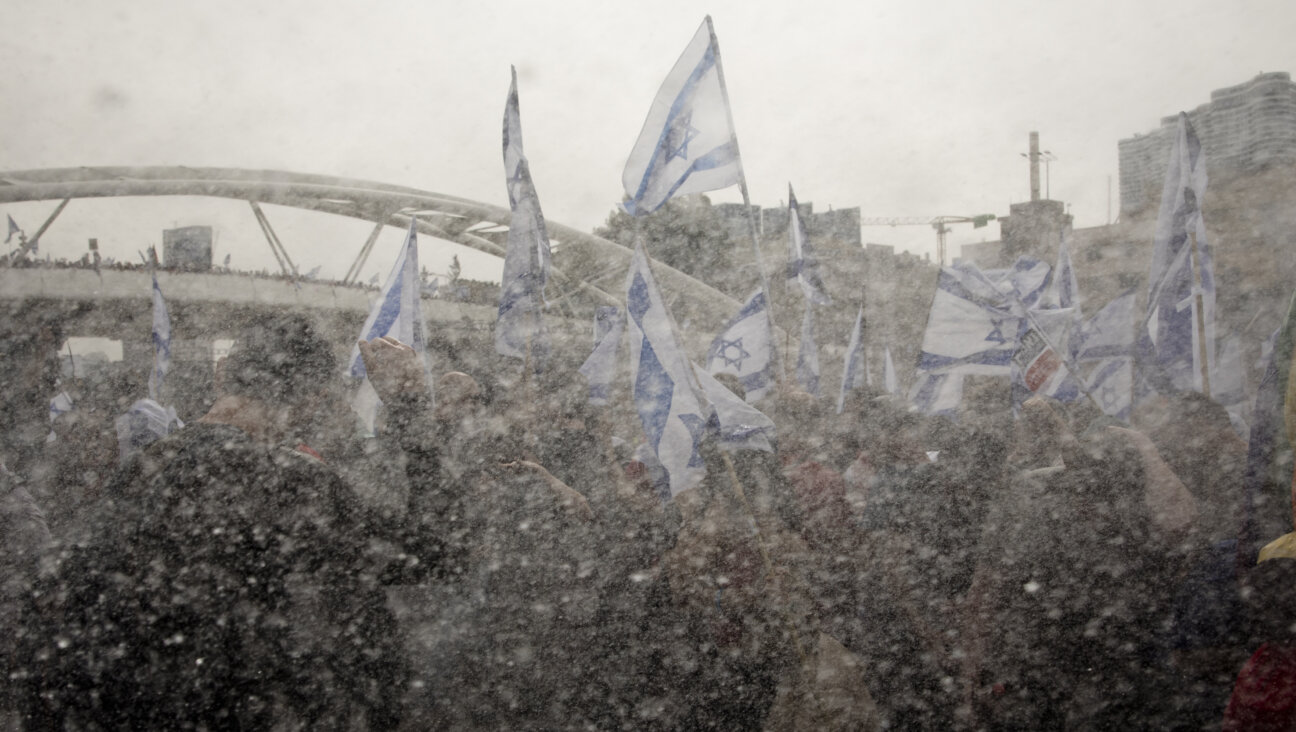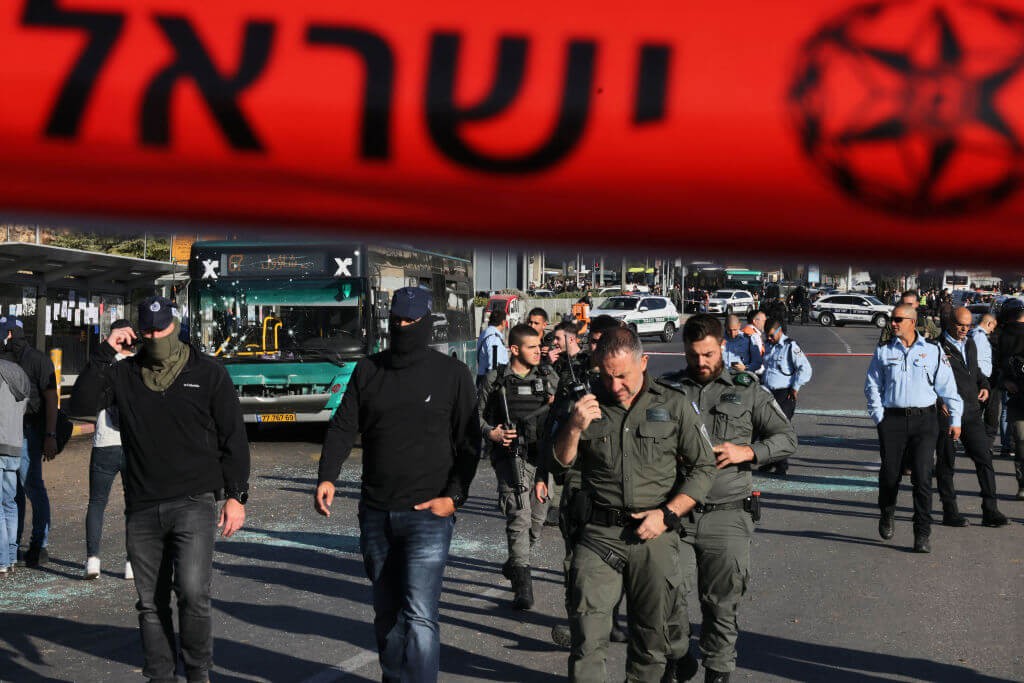One year later, is the Golan’s desolate ‘Trump Heights’ a ‘hoax’?

The sign announcing Ramat Trump today. Image by Ilan Ben Zion
A year ago on Tuesday, the Israeli government held a bombastic ceremony in the Golan Heights to inaugurate Ramat Trump – Hebrew for “Trump Heights” – a new settlement named for the American president as a gesture of thanks for recognizing Israel’s sovereignty over the territory in March 2019.
Today the once gold-lettered Ramat Trump sign is in a pitiful state. Most of the letters have been stripped off by vandals, and the crossed Israeli and American flags are hanging on by a few loose nails. Construction has yet to begin and the weeds grow high.
David Katz is a plain-talking, American-born Israeli cowboy living in the Golan. With his Jack Russell dog in his lap and a horse whinnying in a nearby paddock, he was forthcoming about plans advanced Sunday to build a new settlement named for Donald Trump a couple thousand feet from his porch: “When you plant a tree crooked, it won’t go straight — this is Ramat Trump.”

Golan resident David Katz: “We couldn’t even oppose, because we didn’t have the reins in our hands.”
Katz lives in Qela, a community of 298 people in the northern Golan Heights that will soon be neighbors to a new settlement named for the US president. Not everyone is enthusiastic.
On a hot June day in 2019, scores of government ministers, aides, security details and organizers overwhelmed the tiny community for a brief Cabinet meeting and ceremony that culminated with the unveiling of an enormous sign.
“Many years have passed since we founded a new settlement in the Golan Heights, and today it’s happening,” Israeli Prime Minister Benjamin Netanyahu said, standing before an enormous sign bearing the name “Trump Heights” in gold letters in Hebrew and English. Netanyahu said he hoped that “Ramat Trump will give renewed momentum to the development of the Golan Heights.”
Israel captured the Golan Heights from Syria in the 1967 Six Day War and annexed the territory in 1981. Most of the international community does not recognize the Golan as part of Israel and considers its annexation as illegal under international law. Today, 53 years since the first Israeli settlement in the Golan was founded, slightly more than 20,000 Jews live in the territory. Israel’s West Bank settlements, by comparison, are home to more than 400,000 Israelis.
On Sunday, Netanyahu’s government approved plans to advance the establishment of Ramat Trump, nearly a year to the day after his interim government rubber-stamped the concept.

Israeli Prime Minister Benjamin Netanyahu gives a speech before the newly-unveiled sign for the new settlement of “Ramat Trump”, or “Trump Heights” in English, named after the incumbent US President during an official ceremony in the Golan Heights on June 16, 2019. Image by JALAA MAREY/AFP/Getty Images
The government called for the allocation of 8 million shekels ($2.3 million) for developing Ramat Trump. The first step will be forming a “temporary neighborhood” of prefabricated homes for the first couple dozen families who will move to Ramat Trump in the coming four months, said Golan Regional Council leader Haim Rokach. His office declined to provide the names of any of the families planning to move.
Rokach said in a telephone interview on Monday that Ramat Trump will be a “completely separate” and new settlement that will be built on land expropriated from the existing village of Qela.
The location was chosen because of the existing infrastructure and planning permits, and the process was expedited thanks to “a very serious push in the prime minister’s office,” Rokach said. Qela will be compensated for the land given over to Ramat Trump, he assured.
Establishing a community at Qela has failed several times since the 1980s. A kibbutz founded on the site in the 1980s only lasted a few years. In 1991, a community for Russian immigrants was started, but never hit its target of 300 homes. Today, that core of the settlement — called Bruchim — is home to just a small handful of elderly Russians from the original community. In 2003, a new neighborhood of about 100 families was started just to the west.
Around 25,000 Israelis live in the Golan Heights alongside a similar number of Syrian Druze. The region’s remoteness from the country’s economic center has made development a challenge. The Golan’s economy is heavily reliant on agriculture and tourism, with little else. The nearest supermarket to the future Ramat Trump settlement is in Kiryat Shmona, a half hour drive on narrow unlit roads. The closest hospital is 45 minutes by car in Safed.
Katz has lived in Qela for the past five years. He holds a dim view at the prospects of Ramat Trump’s succeeding, calling the whole endeavor “a hoax.” Because Qela has been under an appointed municipal administrator for the past several years, the villagers had no say in the matter even though most are against it.
“We couldn’t even oppose, because we didn’t have the reins in our hands,” Katz said.
The bottom line, he argued, was that the lack of jobs for prospective newcomers would be a major obstacle to Ramat Trump becoming a reality.
“I brand cattle, grow olives for oil, break-in horses. That’s the way you make a living in the Golan Heights. There’s no high-tech here. There are no bankers,” Katz said. “People here don’t have work. People in this village are barely surviving financially. There are people that live here and drive to Tel Aviv,” around 2.5 hours each way.
Qela had already marketed lots for new homes, but “people are not standing in line to buy. There’s no workplaces in the Golan Heights,” Katz said.
A 2017 survey by Israel’s Central Bureau of Statistics found that the national subregion that includes the Golan Heights has the lowest average monthly income out of any in the country –6,891 shekels ($1,993) and the lowest average hourly wage – 43.2 ($12.5).
Rokach, the regional council leader, dismissed this claim, insisting in a phone interview that “In large part there is no unemployment in the Golan at all.”
“If you’re willing to work, you’ll find work. Not always exactly the work you want, but you’ll find work,” he said. Despite the coronavirus pandemic’s massive impact on tourism, he said the industry has rebounded and “you won’t find a single rental cabin available.”
The regional council said that the plan is for Ramat Trump to be a “mixed” community that combines religious and secular families. Katz and others have raised concerns that by bringing religious families in, it will cause strife and “ruin” the existing secular community.
Katz’s opposition to the idea runs deeper than just economics.
“We can talk about if we really want to have a village named after someone that says ‘I can grab any woman by her pussy and she won’t say no cause I’m famous,’ and if that’s the standards that we want to live by,” Katz said.
Rokach claimed ignorance of such statements. “I don’t know all the politics, all that Trump said.” Rather, Rokach said he deserves the honor because “President Trump says and does, unlike many others.”
Rokach likened Trump’s recognition of Israeli sovereignty over the Golan Heights to declarations by the ancient Persian King Cyrus, who allowed the exiled Judeans to return to Jerusalem and rebuild the temple, and British statesman Lord Balfour, who called for a Jewish homeland in Palestine. “At the end of the process, on the historical level over the years, nobody remembers the exact behavior of Cyrus, if he had one wife and was loyal to her,” he said.
“You can never satisfy 100% of the people,” Rokach said, but he was confident that most of his constituents were behind him. “You have to understand that it’s a process. It doesn’t happen in a day.”
A message from our Publisher & CEO Rachel Fishman Feddersen

I hope you appreciated this article. Before you go, I’d like to ask you to please support the Forward’s award-winning, nonprofit journalism so that we can be prepared for whatever news 2025 brings.
At a time when other newsrooms are closing or cutting back, the Forward has removed its paywall and invested additional resources to report on the ground from Israel and around the U.S. on the impact of the war, rising antisemitism and polarized discourse.
Readers like you make it all possible. Support our work by becoming a Forward Member and connect with our journalism and your community.
— Rachel Fishman Feddersen, Publisher and CEO





























